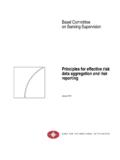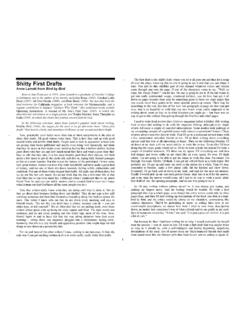Transcription of Reed Canary Grass (Phalaris arundinacea) Management …
1 Reed Canary Grass (Phalaris arundinacea ). Management Guide: Recommendations for Landowners and Restoration Professionals Please cite as: Wisconsin Reed Canary Grass Management Working Group. 2009. Reed Canary Grass (Phalaris arundinacea ). Management Guide: Recommendations for Landowners and Restoration Professionals PUB-FR-428 2009. Introduction How to use this manual trapping silt and constricting waterways, and limits tree regeneration in riparian forests by shading and This guide walks you through the steps you can crowding out seedlings. RCG also decreases retention take to manage reed Canary Grass . Please start at time of nutrients and carbon stored in wetlands, the beginning and see TABLE 1 for a summary of accelerating turnover cycles and reducing the carbon treatment options that can be used. TABLE 2 will sequestration capabilities characteristic of diverse help you conduct a site assessment and decide plant communities. Although its effects on wildlife are which techniques are best suited to your budget and not yet entirely clear, preliminary data suggest that situation, and TABLE 3 lists native species that may habitat specialist species (including several listed and provide competition for reed Canary Grass during protected species) are more adversely affected by reed restoration and Management efforts Canary Grass dominance than habitat generalists.
2 Reed Canary Grass (hereafter RCG) is a threat to the ecological integrity of countless wetlands across Wisconsin. Bernthal and Hatch (2008) found that 1 in 7 wetland acres in their southern and south-central Wisconsin study area were heavily dominated or co-dominated by RCG, and approximately 500,000. acres of wetlands in the entire state are infested. Reversing this pattern will require a large-scale, long-term, cooperative effort from scientists, policy makers, agency professionals, contractors, and non- profit organizations. It will also require cooperation from landowners. Consider taking an active role in the stewardship of our natural heritage through your actions to reduce RCG and promote native biodiversity in Wisconsin's wetlands! This Reed Canary Grass Management Guide provides a template for local-scale RCG abatement, and it summarizes our current understanding of invasion biology and Management tactics for RCG. It is our intention to periodically update this information as new results from ongoing research contributes to our understanding of this species.
3 What is the impact of RCG? The impacts of reed Canary Grass on the habitats it invades are many. RCG greatly reduces botanical and biological diversity by homogenizing habitat structure and environmental variability (both of which correlate with species richness), alters hydrology by RCG in Flower. Reed Canary Grass monotype(s). Life Cycle of reed Canary Grass Reed Canary Grass is an aggressive, cool-season perennial Grass that invades and dominates a variety of wetland types. Invasion typically occurs after disturbance from erosion, sedimentation, nutrient enrichment, road salt inflows, hydrological instability or modification, and restoration efforts that expose bare ground and increase light availability. RCG. responds positively to nutrient inputs, either as fertilizer or nonpoint agricultural runoff. Recently it was discovered that the presence of multiple disturbances, characteristic of many of Wisconsin's wetlands, can interact to accelerate the pace of invasion and native species displacement.
4 Because of its vigorous growth in wet soils, RCG has been intentionally planted since the early 1900's by livestock producers for forage and seed production, and it has been used for erosion control and soil stabilization. RCG reproduces by seed, by stem fragments, and by underground horizontal stems (rhizomes). Field populations have a high degree of genetic variability, and it has been estimated that more than 115. artificially-selected reed Canary Grass genotypes have been developed. It is difficult to determine the genetic origin of a particular RCG stand, although the presence of both green and purple panicles ( Grass flowers) in mid-June point to the existence of different genotypes within the stand. This species is both drought and flood tolerant. Growth and productivity peak twice during the growing season, first in late spring and again in late summer. These growth peaks are under separate genetic control, with leaf and inflorescence growth dominating in the spring and stem and rhizome growth dominating during the late summer peak.
5 RCG is one of the first wetland plants to emerge in the spring, enabling it to shade out native species that emerge later in the growing season. RCG can stay continued Reed Canary Grass Life Cycle continued For a RCG seed to germinate, or for a vegetative fragment to become rooted, a disturbance that creates green and actively growing well past the first killing a bare space is initially required. Seed germination is frost in autumn. Once established, RCG is capable bimodal, peaking in March-May and again in June-July. of rapid clonal expansion, which is enhanced by high Seedlings are vulnerable to Management treatments nutrient and light availability. Species with clonal and inter-specific competition until they become growth mechanisms expand either by employing well-established. New seedlings allocate most of their a phalanx strategy, where tillers mass into an growth to accumulating underground reserves and impenetrable clone expanding over short distances, or developing tillers during the first growing season, a guerilla strategy, where the parent plant forms long generally only needing a single growing season to rhizomes and new tillers emerge at a distance from the become established.
6 Once established, RCG emerges parent clone. RCG uses both the phalanx and guerilla in the spring from rhizome reserves accumulated strategies. It more typically spreads by vegetative during the previous growing season. By using both shoots arising from shallow rhizomes which can extend new energy from photosynthesis and reserve energy RCG root mass. over 10 feet per year and form a thick impenetrable from rhizomes for spring growth, RCG quickly towers mat below the soil surface. These rhizomes have over most other species, preempting all available numerous dormant buds that represent the primary space and light. Since most spring growth occurs mechanism for resurgence when above-ground growth aboveground, the rhizome becomes depleted of starch is removed. Rapid expansion, early growth, and the until flowering. After flowering, rhizomes elongate and mulching effect of a dense litter layer all interact to tiller. Then, in late summer, the plants store energy in facilitate the decline of native species.
7 Few native the rhizome for over-wintering. species can persist indefinitely within a dense clone of RCG. To make matters worse, seeds and vegetative RCG is biennial with respect to flowering. Like many fragments readily float, making streams and ditch cool-season perennial grasses, development of networks effective dispersal corridors, especially flowering stems requires vernalization (a combination during periods of flooding. RCG seed is also dispersed of short day photoperiod and cold temperatures). by humans and wildlife, as the seed adheres readily The new stems that develop from seed or rhizome to moist skin or fur, and is transported in clothing, buds require two years to develop panicles. Flowering equipment, and vehicles. stems often comprise only about 15% of the total stem RCG tillering from rhizome. density per unit area. In spite of this, seed production in monotypic stands can exceed several hundred seeds per plant, and seed can remain viable in the soil for several years.
8 Seed subject to prolonged inundation, however, can lose viability in as few as 2 years. RCG can root from the stem nodes late in the Some members of the genus Carex begin active growing season. growth in early spring and will compete with RCG for light, nutirents and space. Management Considerations Understanding your adversary is key for effective thousands of dormant buds. Therefore, techniques with interseeding additional species, can reverse Management . Following recommendations from this used to suppress above-ground vegetative growth RCG dominance in as little as 2 to 3 years. Once guide does not guarantee control and/or eradication need to be paired with techniques that address the re-established, the native plant community will of RCG. Site-specific conditions and timing variables underground rhizomes and seed bank. Neglecting compete for sunlight, suppressing the RCG seed are likely to influence results. Here are a few important any one component can lead to frustration.
9 Annen bank and re-growth from its dormant bud bank. In points to remember when considering a Management (2008) provides a detailed overview of rhizome bud contrast, formerly cropped sites with few residual program for this species: bank persistence and how to incorporate accessory native plants or seed often have other invasive 1. RCG is persistent and tenacious due to its prolific treatments into your Management program. species present, have higher Management costs, seed rain and dispersal, robust vegetative growth, 2. RCG often invades native plant communities that are and require more years of treatment to establish and dense network of underground rhizomes with under stress or have been disturbed by past farming a desirable replacement plant community. practices. When designing a Management strategy, 6. Finally, practice adaptive Management . No single be sure to consider the probable cause(s) of the RCG recipe works under all conditions.
10 Keep in mind that invasion. Underlying conditions such as high nutrient the techniques, tools and materials presented here levels in the soil, excessive sedimentation, or off-site do not include all available Management options. factors should be addressed, if feasible, in a site- Chemical formulations, for instance, are constantly specific treatment plan. changing, with new products introduced every year. 3. Timing is important, so try to time your treatment After applying a series of treatments, monitor the to achieve multiple benefits. Mowing, burning or plant community response and be willing to change herbiciding with Grass -specific chemicals after reed your techniques when conditions favor a different Canary Grass has achieved some growth in the late approach. Suppression of RCG may result in other spring will reduce or eliminate seed development, invasive or undesirable species attempting to allow release of native vegetation to compete colonize the site.
















